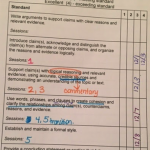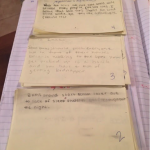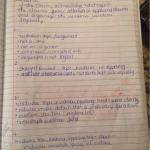
A cynic might say that a “growth mindset” expects students to work with diligence in an area for which they are not genetically gifted, practicing something in which they will never gain excellence.
My journey with growth mindsets has been different.
I’ve found that it’s not about motivating students to necessarily work harder. Instead, it’s an effort to propagate a way of thinking and talking. It’s helping high-achieving students realize that it’s normal to face challenges, and that being challenged is an opportunity to push forward and grow.
Why Our Learning Zones Should Be Risk Tolerant
Daniel Coyle, author of The Talent Code, tells us that “to get good, it’s helpful to be willing, or even enthusiastic, about being bad.”
But what if I am a student who is not enthusiastic about learning from mistakes?
We all have the students who know how “to do” school. They’re the ones that get straight A’s without much effort.
For these students, mistakes are not an opportunity to learn. Instead, they’re a stamp of disapproval. So, we need to be conscientious about our feedback–giving feedback on things students can control, like their effort, challenge-seeking, and persistence.
This means feedback should also avoid praise for children’s “smartness.” At the same time, we can help students understand that effort is not simply doing something for a long time, or doing the same thing over and over; but that it is seeking out challenges, setting goals, making plans, and using creative strategies to achieve those goals.
Language Matters when We Give Feedback
We need to support our students with lots of growth-mindset language. Students need to be praised for taking risks. That might mean saying, “Thank you! You just stretched our learning today.”
In that way, we show that mistakes are building blocks to our learning. Students need to be praised for looking at situations in new and different ways, and thanked for giving the learning community the opportunity to explore their thinking.
Yes, We Need High Expectations
Grant Cardone, in The 10x Rule, reminds us that success is important to our self-identity. “It promotes confidence, imagination, and a sense of security and emphasizes the significance of making a contribution,” he writes.
It’s an important lesson, but one that has been twisted over the years.
So many of our students have a sense of entitlement. Many times “the target” is lowered in order to make the student feel “successful.” But is that success? I don’t think so.
Success is about setting goals, working hard–and then even harder–until you reach your target. It’s not enough to just play the game.
Perhaps most overarching is the idea that we are all unfinished human beings. There is always room for change. Even when you think you have reached the top of your game, a growth mindset person is continually looking to reach higher: not to please others but to just become a better human being.
 Tina Luchow (@tluchow25) is a fifth grade teacher at Oakwood Elementary, in the Brandon School District. She is in her eleventh year teaching upper elementary students, fifth and sixth grade, in the areas of math, reading, writing, and language conventions. Tina has studied reading and writing workshop practice, conducted action research, and is a 2017 Oakland Writing Project Teacher Consultant. Tina attended Baker College for her undergraduate degree in education, and Marygrove College for her Masters in the Art of Education with a focus in Reading. Unlike your average perfectionist, Tina understands that “good enough” falls around the 50th consecutive attempt to hang a poster completely level. How does she do it? An unwavering commitment to the sole source of her strength: yogurt, granola, and tea.
Tina Luchow (@tluchow25) is a fifth grade teacher at Oakwood Elementary, in the Brandon School District. She is in her eleventh year teaching upper elementary students, fifth and sixth grade, in the areas of math, reading, writing, and language conventions. Tina has studied reading and writing workshop practice, conducted action research, and is a 2017 Oakland Writing Project Teacher Consultant. Tina attended Baker College for her undergraduate degree in education, and Marygrove College for her Masters in the Art of Education with a focus in Reading. Unlike your average perfectionist, Tina understands that “good enough” falls around the 50th consecutive attempt to hang a poster completely level. How does she do it? An unwavering commitment to the sole source of her strength: yogurt, granola, and tea.

 I think it’s safe to say that there’s a bit more mathematical calculation in your normal English classroom pedagogy than there was, say, five years ago.
I think it’s safe to say that there’s a bit more mathematical calculation in your normal English classroom pedagogy than there was, say, five years ago. 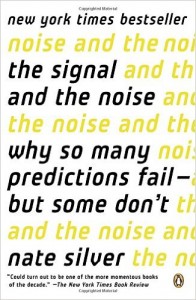 The funny thing about data, though, is that numbers aren’t as clear and objective as all those charts and bar graphs would have us believe. If you don’t want to take an English teacher’s word for that, get ahold of Nate Silver’s
The funny thing about data, though, is that numbers aren’t as clear and objective as all those charts and bar graphs would have us believe. If you don’t want to take an English teacher’s word for that, get ahold of Nate Silver’s 

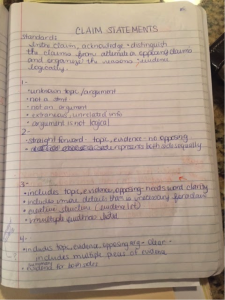
 Amy Gurney is an 8th grade Language Arts teacher for Bloomfield Hills School District. She was a facilitator for the release of the
Amy Gurney is an 8th grade Language Arts teacher for Bloomfield Hills School District. She was a facilitator for the release of the  For the next two years, I will be part of the
For the next two years, I will be part of the 